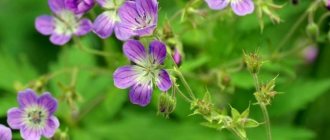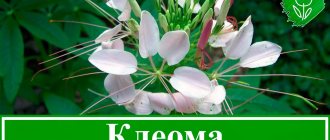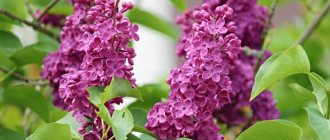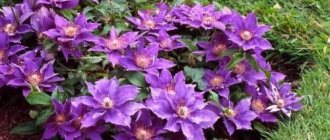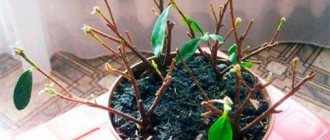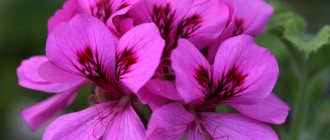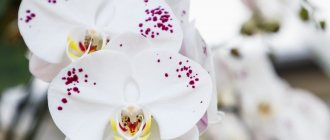Preparing indoor geraniums for winter
Pelargonium is capable of blooming and vegetating almost constantly, but, like any plant, it needs to rest and gain strength. The dormant period of this flower crop is quite short and does not exceed three months. At the beginning of December, the flower enters the sleep phase and wakes up towards the end of February. Carrying out planned care for pelargonium in the fall (September or October), at the same time they begin preparing for winter.
Slowly and carefully lower the air temperature in the room, providing coolness. During the daytime, the thermometer should not rise above +16…+18 °C. At the same time, reduce the number of waterings. Autumn-blooming geraniums, during the gradual transition to wintering, do not stop producing fresh buds, but the growth of new shoots will slow down somewhat, as the plant begins to save its energy.
It is extremely important to trim the bush on time without waiting for the start of winter dormancy. This is done thoroughly, removing approximately half of the crown so that the plant is evenly illuminated by the sun and well ventilated in winter. In this case, the risk of fungal infections is minimized.
In the autumn and winter months, geraniums are usually not replanted, but cuttings obtained during routine pruning and crown shaping can be rooted.
Royal geranium - pruning features
The pruning technology described above is suitable for most varieties of unpretentious zonal geraniums. But there are flower varieties that are more demanding to care for, including pruning. These include grandiflora or royal geranium. It blooms with unusually beautiful, and most importantly large, flowers, which is why it is often called grandiflora geranium.
One flower in diameter can reach from 5 to 7 cm. But their decorativeness does not end there, since the petals are often corrugated, and the colors are simply amazing in their diversity. You will not find monochromatic flowers on this type of plant. They are always decorated with some kind of spots, rims, or stripes. Outwardly they strongly resemble petunia.
But such beauty does not come without drawbacks. The main ones are demanding care and a short flowering period. If ordinary, zonal geraniums can bloom almost all year round, then grandiflora will delight with its inflorescences only 3-4 months per season. This will happen only if proper care is provided for it.
Knowing its capricious nature, flower owners are interested in how to prune royal geranium so that in the spring the wayward beauty will fully demonstrate all the varietal qualities inherent in it. The first step is to decide when to replant and prune large-flowered geranium - in autumn or spring. In this case, only the autumn period is suitable for pruning. Two problems are solved at once - the bush is preparing for wintering and material is being collected for further breeding of the variety - cuttings.
Unremarkable, familiar to everyone since childhood, geranium, with proper care and timely, competent pruning, can turn into a completely exclusive, very beautiful plant. Anyone can create a long-flowering masterpiece on their windowsill; to do this, it is enough to trim the pelargonium at the right time and provide it with comfortable conditions for intensive growth.
Conditions necessary for a geranium flower in winter
In order for pelargonium to safely overwinter and delight you with lush flowering next season, it is necessary to take proper care of it in winter and provide all the necessary conditions for this.
Lighting
Geranium is very photophilous and can withstand even direct, burning rays of the sun. It is best to move the pot for the winter to the windowsill facing south. Full lighting will be required, lasting at least 12 hours, so the plant will have to be additionally illuminated by installing fluorescent or special phytolamps above it (10-12 cm from the top of the head). If this is not done, the shoots will stretch out.
Under no circumstances should geranium leaves be allowed to touch glass in winter, as they will get frostbite.
Air temperature and humidity
A room temperature in winter of about +14…+16 °C will be the most comfortable for pelargonium. At night it should not be colder than +10...+12 °C, otherwise the bush will freeze, throw off all the foliage and may even die. Drafts pose a particular danger to this delicate crop; the room must be ventilated with extreme caution. To avoid hypothermia and freezing of the root system, it is not recommended to place the pot directly on a cold windowsill; it is necessary to place a piece of thick cardboard or foam underneath.
In exceptional cases, pelargonium can survive short-term cold snaps down to +6 °C without damage. Too dry air is detrimental for geraniums, especially if there are operating heating devices nearby, however, it is difficult to tolerate spraying of leaves in winter. You can place a couple of small wide bowls or jars of water in close proximity, which will increase the humidity through evaporation. Household humidifiers will also help solve this problem.
Watering
If you are in a fairly cool room in winter, you do not need to water pelargonium often. Excessive moisture can quickly destroy a plant, since in dampness and swampiness the roots are affected by fungal infections and quickly rot. The substrate should be only slightly moist, because it is important to simply prevent the clod of earth and, accordingly, the root system from drying out completely. Watering is carried out no more than once every 10-14 days and only when the top soil layer (1-2 cm deep) in the pot dries out. It is better to do this in the first half of the day so that the earth dries out a little by night.
Excess liquid that spills into the pan through the drainage holes is immediately drained. Use well-settled, soft, lukewarm or room temperature water. If the room is very warm (not lower than +20 °C), then you will have to moisten the flower more often, almost the same as in summer.
Feeding
In winter, geraniums that are in a dormant period are rarely fed with fertilizers, no more than once every 3-4 weeks. Experienced flower growers advise using specialized formulations designed specifically for pelargonium. Any mineral complex for flowering plants with a minimum content of nitrogen elements is also suitable. To avoid burning the roots, the plant needs to be watered before feeding. If the room is hot, then fertilizers are not applied at all, since after this the crop can actively begin to grow instead of resting.
Nitrogen can provoke an unnecessary release of fresh shoots, which will take away the strength of a resting flower.
Growing conditions and care features for geraniums to bloom
Geranium feels best in well-lit places and only on the hottest days requires light shading from the sun's rays.
If the pot is placed in a north window or in the back of the room, the gardener should expect that with insufficient lighting the shoots will stretch out and the plant will lose its compactness and decorativeness. How to care for geraniums at home if it is not possible to bring them into the light, or lack of lighting threatens the plant in winter? In winter, when kept on a loggia or on northern windows, it is useful to use special phytolamps. Extending daylight hours to 12–14 hours has a good effect on:
- to maintain the shape of the bush;
- on the uniformity of shoot growth and their quality.
In geranium bushes that receive enough light, the newly formed stems have a rich color. The same applies to the foliage, which does not become smaller or paler, but remains juicy and bright.
In order for geraniums to bloom, caring for them necessarily involves maintaining a room temperature that is comfortable for the crop. It is best if the air in the room where the pot is:
- in summer it warms up to 22–27 °C;
- In winter, during the dormant period, the temperature is about 12–16 °C.
Plants respond well to ventilation, but like other indoor crops, they do not like cold drafts. Being near hot radiators, geranium will also experience discomfort.
How to prune pelargonium for the winter
Without competent and, what is extremely important, timely pruning of pelargonium in the fall, it is impossible to obtain a spectacular, beautifully flowering and healthy plant, and no amount of care, even the most careful in winter, will help maintain its decorative appearance. The plant, which is not subjected to cultivation and formative pruning, stretches out, becomes bare and practically does not bloom.
When carried out correctly and at the right time, the procedure stimulates the ejection of additional side stems and the formation of a much larger number of flower buds. The bush grows compact and neat, without producing unsightly bare shoots, and also blooms longer and more luxuriantly.
Geranium or pelargonium - who is it and where does it come from?
Geranium (pelargonium) is an unpretentious, herbaceous or semi-shrub flower brought from Africa in the 17th century. Based on the data in the Latin (geranium) and ancient Greek dictionaries (γεράνιον), it can be understood that the name of the plant was given based on the external resemblance of the shape of the fruit to a crane’s beak.
The geranium group consists of 400 varieties. Although Africa is the birthplace of the houseplant geranium, pelargonium has become widespread on almost all continents due to its bright, voluminous flowers and general decorative qualities. Interest in some varieties of pelargonium is due not only to the external characteristics of the flower, as can be seen in the photo, but also to its medicinal properties.
The first mentions of indoor geranium in Russia date back to the middle of the 18th century.
How to care for geraniums in winter
Geranium is an unpretentious flower, but in winter it is quite delicate, and it must be handled with care, without creating serious stressful situations for it.
Basic conditions for keeping geraniums in winter
The main features of winter geranium maintenance look like this:
- a cool but not cold place (for example, a south-facing window sill);
- daylight hours lasting at least 12 hours;
- a slight decrease in the amount of watering compared to summer;
- very infrequent feeding (2-3 times per winter is enough);
- systematic pruning.
Transplanting geraniums in winter is possible in principle, but is not recommended: the slightest violation in technology can lead to disease and death of the plant.
Preparing geraniums for winter
Geraniums have a period of relative rest from November to February. During this time, the flower must be kept cool; the temperature during the day should not be higher than 16–18 o C. The temperature is lowered gradually, this is done during cloudy days, while simultaneously reducing watering. This allows even flowering geraniums to save their energy, since it slows down the growth of new shoots. Flowering will not stop and may continue until January.
It is very important to thoroughly prune the plant in time, before the onset of winter. This is necessary for good ventilation and illumination of every part of the plant in winter. As a result of pruning, about half of the bush is left:
- at the end of September or beginning of October, the peduncles are removed (those with flowers can be left alone, but many amateurs remove everything, providing the geranium with winter dormancy);
- all fading and yellowed leaves are plucked off;
- shoots are cut just above the branching points.
Many gardeners keep geraniums blooming until the New Year, but they often cut them back heavily, preventing them from continuing to bloom.
At the same time, you should not worry that the geranium loses its lushness: this is necessary for a good wintering.
You don’t have to throw away the cut stems, but try to root them.
Lighting
Geranium is very light-loving; it will need good lighting in winter. The intensity of solar radiation on a southern windowsill will be sufficient, but daylight hours in winter are short, and it must be extended to 12 hours using artificial lighting. White light fluorescent lamps or special phytolamps are placed above the plant, 10–15 cm from its crown.
Temperature, humidity
The temperature on the windowsill at night should not fall below 10–12 o C; during the day it should be several degrees warmer. If the room is too cold, geraniums may freeze and drop their leaves. It is especially necessary to protect the root system from freezing: usually the pot is placed not on a bare windowsill, but under a sheet of foam plastic. Drafts are even more dangerous.
When moving the pot to the glass, you must first check how well it holds home heat
Geranium does not like very dry air, so if there is a heating radiator nearby, it is worth placing a regular jar of water near the pot, the evaporation from which is often sufficient. In difficult cases, it is necessary to use household air humidifiers, but in no case should you spray the leaves.
Nutrition, watering
Water geraniums in winter twice a month in the morning very sparingly. Feed monthly using any complex fertilizer with a minimum nitrogen content. It’s even better to purchase special fertilizers for geraniums in the store. If the room is too warm, fertilize even less frequently so as not to stimulate excessive shoot growth. Before feeding, the flower must be watered.
Trimming
The main pruning was carried out in the fall, so during the winter they only remove yellowed and wilted leaves and flowers. However, some varieties of geranium require pruning at the end of winter, before the onset of a warm period. So, variegated varieties try to practically not prune before winter, but do it in the spring. Ampelous varieties are pruned as needed at any time when they grow too much. The condition of the cutting areas in winter must be carefully monitored: if they become blackened, the sections are renewed.
Types and varieties
Most often in home floriculture, zonal geranium, or kalachik, as it is still called in common parlance, is used. It is distinguished by dark concentric circles on the leaves, grows up to 30-60 cm in height, sometimes even up to a meter, blooms with simple or double bright flowers, collected in spherical umbrella inflorescences of red, crimson, white or pink.
Geranium ivy, or thyroid
An ampelous plant for hanging flowerpots with fragile hanging shoots up to a meter long and with racemose inflorescences of simple, semi-double and double flowers in a wide palette of colors.
Royal or English grandiflora geranium
It is homemade, royal noble) is represented by many varieties, shapes and colors, sometimes with variegated leaves, with simple and double flowers. The height of the plant is up to half a meter, and is distinguished by a dark spot or stripes along the veins on the lower petals.
In the photo: Ivy-leaved geranium
Fragrant geraniums
With the scent of lemon, almond, pepper, lemon balm, mint, ginger, pineapple, strawberry, coconut, pine when touched, the leaves are truly a miracle of nature, used to obtain geranium oil, valuable for the cosmetic, medical and food industries. Their flowers are small, pinkish or purple.
Angels
Geraniums, similar to pansies, bloom with hanging caps of inflorescences. They are compact bushes up to 30 cm high.
- Photo of indoor adenium
In the photo: Royal geranium
Uniques
A hybrid of shiny and royal geraniums with strongly dissected leaves and a spicy scent. Flowers of incredible beauty are similar to the inflorescences of royal geranium.
Geraniums succulent
They are represented by 10 species: with spines, like cacti, and without spines. They are interesting for their decoratively curved stems, reminiscent of small baobabs. Used to create bonsai.
Care for geraniums in winter
Geranium is an unpretentious plant, but in order for it to bloom in winter, it needs more careful care. With the onset of autumn, many flowers need to be moved to a place protected from the cold. Geranium is one of these plants. It must be carried so that it does not experience stress from sudden changes in temperature (Figure 1).
Note: Some varieties bloom almost all year round, so by moving them indoors you need to create optimal conditions.
The basic requirements for caring for geraniums in winter are:
- In cold weather, it is better to place it in a cool room. A south window works well.
- The plant will not disappear even with partial darkening, but then there will be no abundant flowering. Daylight hours for the crop should be 12 hours.
- In winter, the amount of watering is reduced, since low temperatures and high humidity can cause root rot. The plant should also not be dried out too much - it will begin to wither, turn yellow, and shed its leaves.
- You only need to feed the flower once every month and a half.
- Winter care also involves constant pruning of branches. If this is not done, the flower will lose its decorative effect and become unattractive. By carrying out timely and high-quality pruning of the crown, the geranium will become lush, and the flowering will be beautiful and long-lasting.
Figure 1. Under certain conditions, the plant will bloom in winter
It is not recommended to replant a flower in winter, because its growth slows down, and otherwise it will not take root.
Features of growing geraniums
At the end of the 16th century, this plant was brought from Africa to Europe. An English botanist, who grew various greens and flowers at the king’s court, was able to develop three species of this amazing ornamental plant from geranium seeds.
Europeans began to breed “kalachik” everywhere, since it constantly pleased its owners with lush and abundant flowering throughout the year. In addition, pelargonium had a lot of positive properties. To date, more than 280 varieties of geranium have been identified, among which you can find annuals and perennials, shrubs and subshrubs, and the range of colors is simply amazing.
Caring for geraniums is quite simple and does not differ from the growth period. Like most other plant species, pelargonium stops active development in winter and goes into hibernation. Therefore, the activity of caring for the “curl” during the winter period is significantly reduced. Feeding (starting in September) and watering are reduced. Full feeding and watering resume around April. In winter, watering should be reduced by half, or even more, depending on soil moisture. Excessive soil moisture in winter will certainly lead to the death of this unique plant.
The temperature in winter should be +10°C - +15°C, and not lower than +8°C. As for hanging species, temperatures below +12°C can be detrimental for them. Since geranium loves light very much, you will have to organize additional lighting with special sources, especially in winter. Alternatively, you can turn on an energy-saving lamp, as it provides a lot of light with minimal energy consumption.
Preparing geraniums for winter
The end of growth and the transition to a dormant state for plants occurs in September-October. For geraniums, the dormant period begins from November to February. At this time, the flower is kept in a cool room (8-10 degrees), carefully watered, avoiding overflow (Figure 2).
Figure 2. Preparing a houseplant for winter
If the weather is sunny in September, then the flower has enough light to continue flowering. The longer the weather is warm, the more nutrients the plant spends, which is why they often need to be watered and fed. With the onset of cloudy and rainy days, the flower pots are transferred to a cool place, watering is carried out moderately.
Note: In winter, in warm rooms, the flowers grow vigorously, forming light shoots that are cut off in the spring. In a cool place, it smoothly goes into a dormant state, slowing down its growth and sparingly consuming nutrients.
If your geranium was in the ground in the summer, then, with the onset of cold weather, you should dig it up, cut off one third of the roots and plant it in a small pot, and also trim the bush itself. The flower pot must be placed in a dry, sunny place. Remember that the crop does not like sudden changes in microclimate, otherwise the leaves may turn yellow and dry out. You need to moisten the soil as it dries.
Appearance tells about your appetite
Long-term flowering can only be achieved if the plant has enough nutrients. You can find out which element of geranium is missing by its appearance.
If the plant does not have enough nitrogen, the leaves begin to turn yellow from the edges.
In some varieties, instead of a yellowish color, reddish or pink pigmentation appears. However, nitrogen fertilizing should be applied as carefully as possible, since an excess of this substance can lead to active growth of green mass, which will cause a lack of flowering.
If geranium lacks iron, the veins of young leaves begin to turn yellow, and if there is magnesium, the veins of old leaves begin to turn yellow.
A lack of phosphorus is indicated by dark green leaves, which over time begin to curl and plant growth slows down. Deficiency of this element also has a negative effect on leaf size, stem thickness and root development.
Potassium increases protective functions, in particular resistance to cold and disease. With a lack of this element, the leaves of the plant become small and dark. In addition, the internodes become short, which makes the entire plant look more compact. You can also notice reddish-pink pigmentation on the leaves.
Calcium is necessary for proper cell division, and therefore the growth of geraniums.
In the initial stages of a lack of this element, the root system suffers, and black necrosis can be seen at the tips of the roots. In more severe cases, the problem affects primary and secondary roots, causing the lower leaves to wither and die. Young leaves and shoot tips may also be damaged due to this problem.
To compensate for the lack of nutrients, it is recommended to fertilize the flower once every 2 weeks with complex additives, which contain all the necessary substances, in particular phosphorus, potassium, calcium, iron and nitrogen.
In addition, you can use iodine, which not only stimulates flowering, but also protects the plant from fungal diseases. To do this, iodine must be diluted with water at the rate of 2 drops per 1 liter of water. Water the plants with the resulting solution at the rate of 50 ml per 1 pot every 10 days.
How to care for geraniums in winter
Geranium is not very demanding in terms of care and can live in almost any room. But with the arrival of cold weather, caring for it will change a little. With proper care, the plant will delight you with its flowering until January.
Traditional plant care measures include proper lighting (including artificial lighting), timely but moderate feeding, and ensuring optimal temperature conditions in the room.
Lighting
This is a very light-loving plant, so the best place to place it in winter would be a south-facing window sill. It is the most illuminated and the flower will grow and bloom well there. But you should be careful, since constant exposure to ultraviolet radiation can lead to severe burns, which will cause the death of the flower (Figure 3).
Figure 3. The best place for a flower is a window facing south
The duration of daylight should be at least 12 hours. If you leave a flower in a shaded place, there is a chance that its leaves will not develop and will remain small. To prevent this from happening, it is necessary to provide the plant with additional lighting. This can be done using a special lamp placed at a height of 10 cm from the top of the plant. As a rule, phytolamps are used for this purpose, but it can be successfully replaced with a conventional fluorescent lamp or fluorescent lamp.
Indoor geranium - plant features
Geranium grows in all corners of the globe, taking root in both mountains and tropical forests. It is found in the Caucasus, but South Africa is considered the birthplace of the houseplant. Sailors brought it to Europe in the 18th century, and geranium immediately won the attention of European aristocrats with gardens.
The flower arrived in Russia a century later and at first was available only to rich people. Over time, the exotic plant became affordable and settled in almost every home.
The shape of the leaves varies greatly among different species. They may resemble a human palm or have sharp tips. The most popular type of indoor plant is called pelargonium.
It is this species of the geranium family that came from the hot continent, and therefore prefers warm and dry air. In winter, it requires additional lighting due to the short daylight hours, but a humidifier is not needed.
Like other indoor plants, pelargonium is comfortable at a temperature of 20-25 ° C. It reaches a height of 15 cm to 1.5 m.
Flower growers also appreciate the beneficial properties of geranium. The aroma of the leaves calms the nervous system and relieves stress. A flower growing at home effectively disinfects the air, destroying viruses and germs.
The beneficial substances and compounds contained in the leaves allow you to treat bruises, swelling, joint pain and colds with geranium essential oil. The only serious contraindication is the use of medicinal products based on the plant on an empty stomach.
How to prune geraniums for the winter at home
The dormant period of the plant begins in the fall and the main thing that needs to be done is to prune it. In the future, this will serve as the foundation for future inflorescences. If the following conditions are met, but without pruning the flower, one cannot talk about beautiful and lush inflorescences in the future (Figure 6).
The trimming sequence is as follows:
- At the end of September, all peduncles and flowering ones are also cut off: this procedure will preserve their beneficial substances for the winter.
- Yellowed or wilted leaves are plucked off: it is recommended to pinch them off rather than cut them with scissors. The scissors leave behind mere protruding roots, which can later begin to rot and lead to disease or even death of the plant.
- To get dense flowering, in September the flower is cut before the branches begin or just above (3-5 centimeters) the node. The cut top part can be rooted as a cutting for propagation.
Figure 6. Basic types of pruning: pinching and shortening
The plant is pruned until it loses its lush appearance. Don’t worry that the crop will lose its attractive appearance: such radical pruning will help save nutrients and give the crop the opportunity to grow young, lush shoots.
If your flower is still young, then just pinch it, adhering to the following rules:
- Young plants begin to be pinched when their height reaches 5-6 centimeters.
- The next pinching is carried out when the plant has grown another 5 centimeters.
- To give the flower a spherical shape, pinch it a third time in a similar pattern.
Plant pruning can be done both in autumn and spring, depending on the variety. For example, zonal ones grow, and if the branching is not very long, they don’t need to be pruned, and it’s better not to touch small plants at all until spring.
For variegated varieties, pruning is very stressful, so pruning is best done in the spring. Ampelous varieties are pruned when they grow strongly.
Yellowed leaves and flowers must be removed constantly, regardless of the variety, but trimming the stem is individual for each variety. For small flowers, pruning is not so important, but for larger plants it is of great importance.
Autumn pruning of geraniums for lush flowering
Let me emphasize again: you have no alternative to pruning. If you don't take care of your geranium bush, it will quickly lose its shape, in just a couple of seasons. The lower part of the stem loses its leaves; greenery remains only at the top of the plant. Therefore, if you do not plan to part with your pelargonium, then you should master the technique of pruning the plant for the winter.
Perennial pelargonium needs pruning 2 times a year - in spring and autumn.
The problem is that geranium always stretches upward, and without your help it will not be able to produce side shoots. And only pruning (or a more gentle procedure - pinching) will help to form a beautiful crown and stimulate the growth of side shoots.
When you prune a plant, it helps awaken dormant buds in the trunk that cannot be activated otherwise. In addition, this procedure contributes to the formation of new buds in the future: it has been noticed that geraniums that have been pinched or pruned produce more inflorescences and look much more elegant than a bush that has only been watered but not pruned.
Pruning not only decorates the appearance, it promotes the formation of a large number of large inflorescences and increases the duration of their flowering.
As a fallback, if you miss pruning time and your flower still looks unsightly, you can take a couple of young cuttings from the top of the plant and grow new geraniums. It should be remembered that if you completely neglect your geranium, it will turn out to be useless even in terms of planting material, and it may simply die.
What can geranium cause and how to treat it?
Despite its high resistance to diseases, geranium is affected by gray mold, root collar rot and is attacked by aphids and scale insects.
In case of gray rot, the plant is transferred to dry mode and treated with an antifungal drug. It is unlikely that the plant can be saved from root rot. They fight against aphids and scale insects using quarantine regime insecticides (to avoid the transmission of pests to other flowers).
How to get rid of midges in indoor flowers using simple methods. In a special publication on our portal, we will talk in detail about how to get rid of midges on indoor flowers, why they appear, how to avoid their appearance and preventive measures.
What to do: geranium leaves are turning yellow
The first reason is the incorrect concentration of fertilizers, namely an excess of nitrogen. For some time, the plant should be left alone and stop fertilizing.
The second reason may be a pot that is disproportionate to the plant. Try replanting the plant in a smaller pot.
Why doesn't geranium bloom?
There may be several reasons. The most important thing is a lack of nutrients. It will be replenished with complete flower fertilizer. The second common reason is considered to be lack of lighting. Try moving the plant to the sunniest spot in the house.
If the plant is often overdried, then it may not bloom at all.
Geranium bush without flowers
Why does geranium dry out?
The flower may dry out if the pot is too small. Transfer the plant to a larger pot.
The second reason is the proximity to the battery in winter.
Drying geranium
If geranium leaves turn red
There are three reasons: lack of magnesium, low temperature, fungal diseases.
We will compensate for the lack of magnesium with fertilizer, and if we suspect a disease, we spray the geranium with a fungicide.
Blushed geranium
How to replant geraniums: tips
Geraniums are replanted in the following cases:
- roots are peeking out of the drainage hole;
- the plant does not bloom, despite intensive care;
- the soil dries out too quickly, which means the pot has become cramped.
If the previous container has become cramped, take a new one only 2-3 cm larger. Wash the pot with bleach for disinfection, dry it and fill the bottom with drainage. Add some fresh soil. To extract, water the soil and gently knock on the walls of the pot. So, the earthen lump gathers around the roots and lags behind the walls of the pot. Carefully inspect the roots; cut off damaged ones with a clean knife. An earthen ball with a flower is lowered into a new pot, the space is tightly filled with new soil. Now you need to water the plant generously and put it in the shade for 5-7 days.
DO NOT FORGET!
A freshly transplanted plant does not need feeding for 2 months!
Geranium transplantation process
